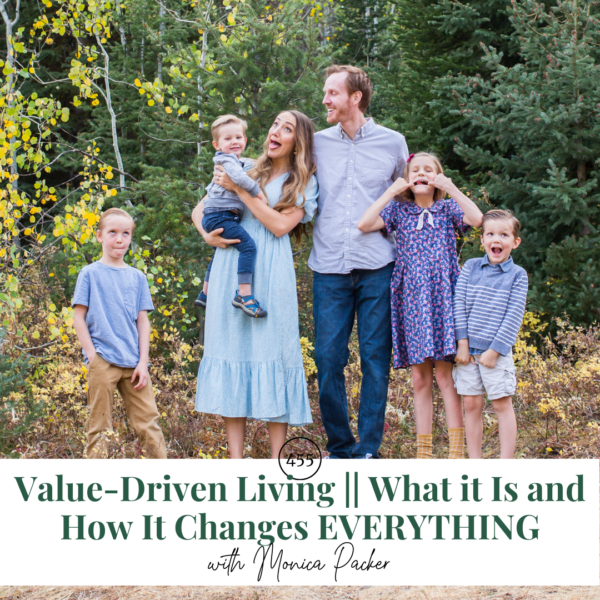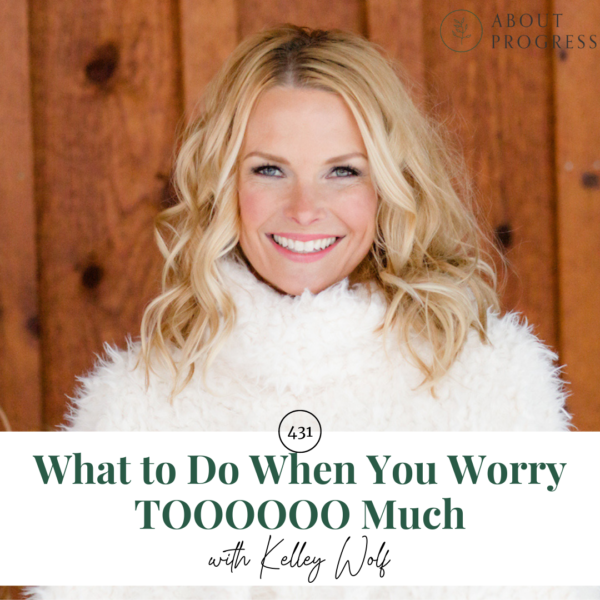Rewire your brain with specific and actionable ways to practice feeling good emotions to fuel your goals.
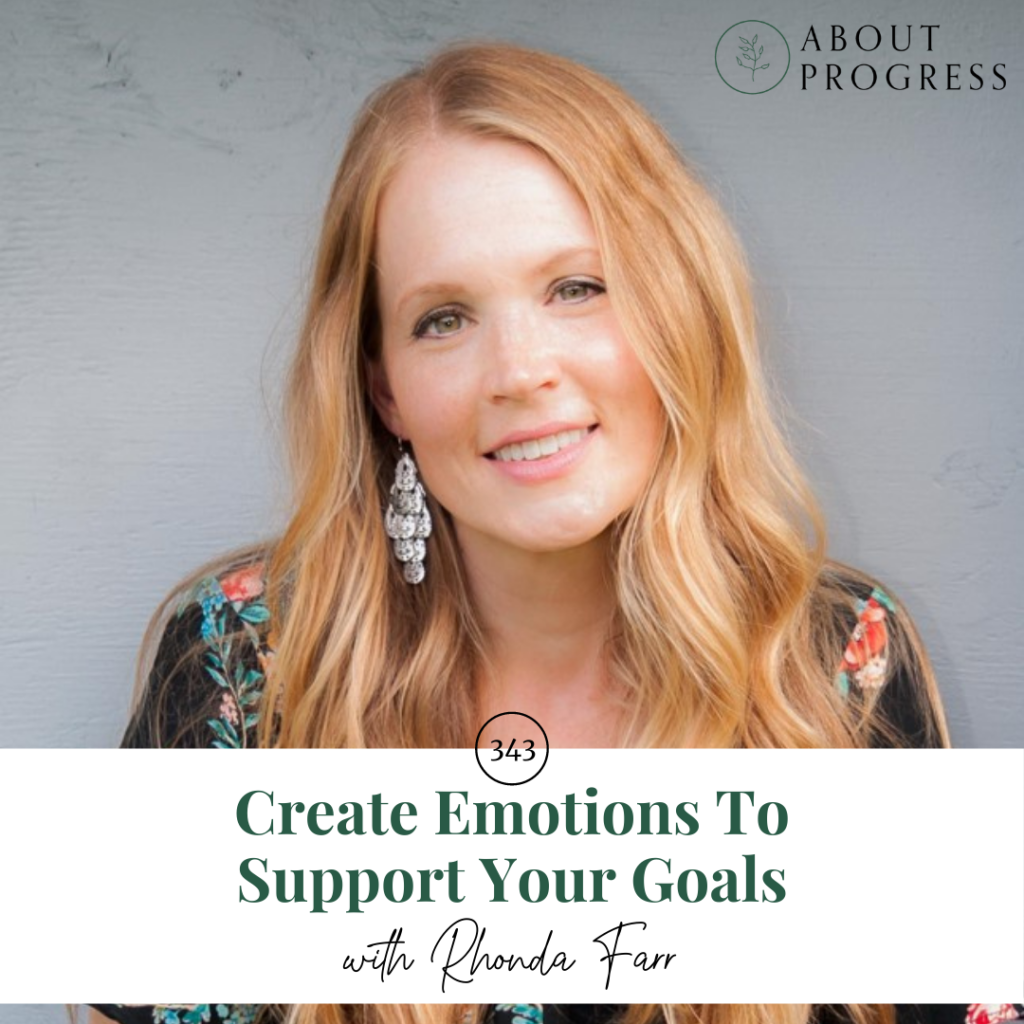
When you think of your goals, how do you feel? Is it stressful, overwhelming, fearful? Do you rush to the “how?” Would you rather feel joy and peace and gratitude? You’re not alone, tune in to today’s episode to learn how to create emotions to support your goals. Just know that we’re not going to skip the hard emotions, we’re going to acknowledge them but not indulge them, as we rewire how our brain fires.
Rhonda Farr is a former counselor for at-risk youth, who now focuses on emotional skills while coaching others towards their goals. She emphasizes the acknowledgement that many of the tough emotions we face are a result of conditioning, and not our fault. Through practicing connecting to positive and grounding emotions, which she walks listeners through, you can rewire the connections that your brain makes to be positive and supportive.
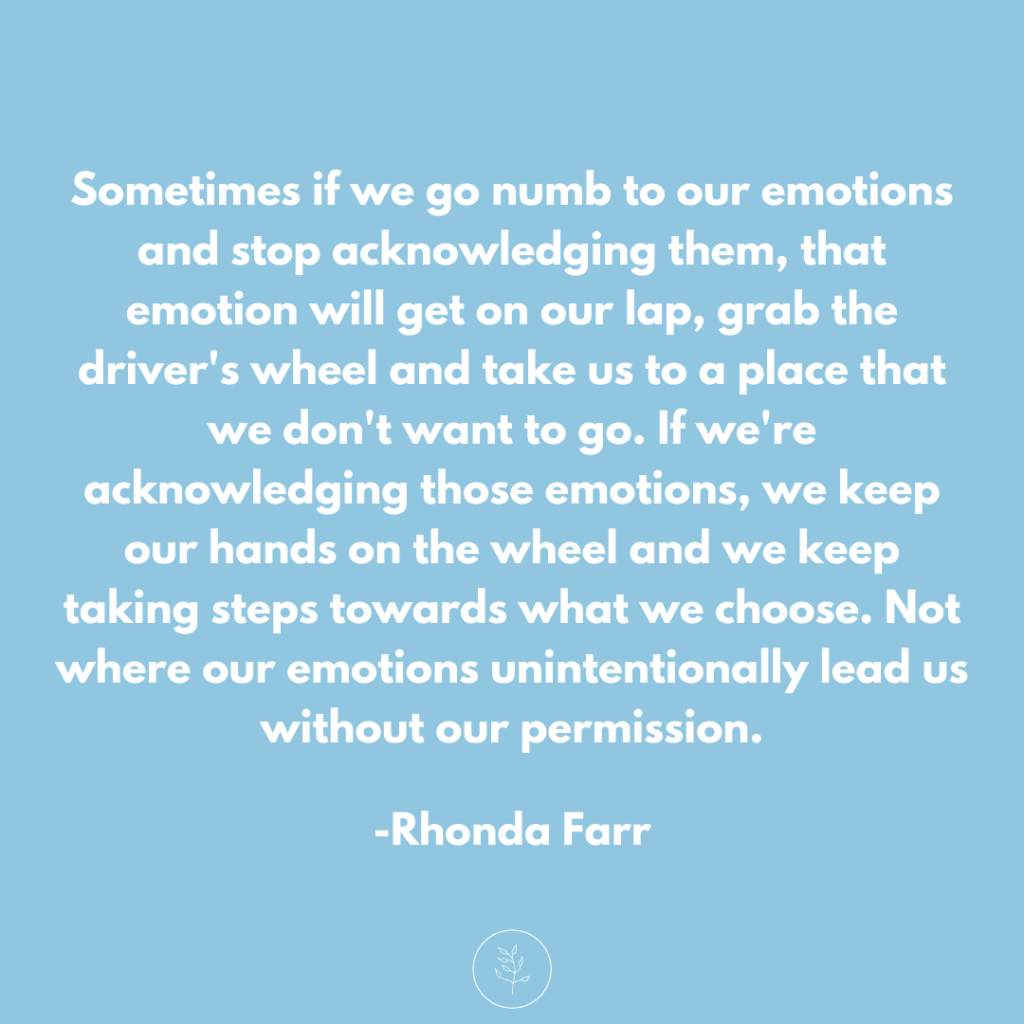
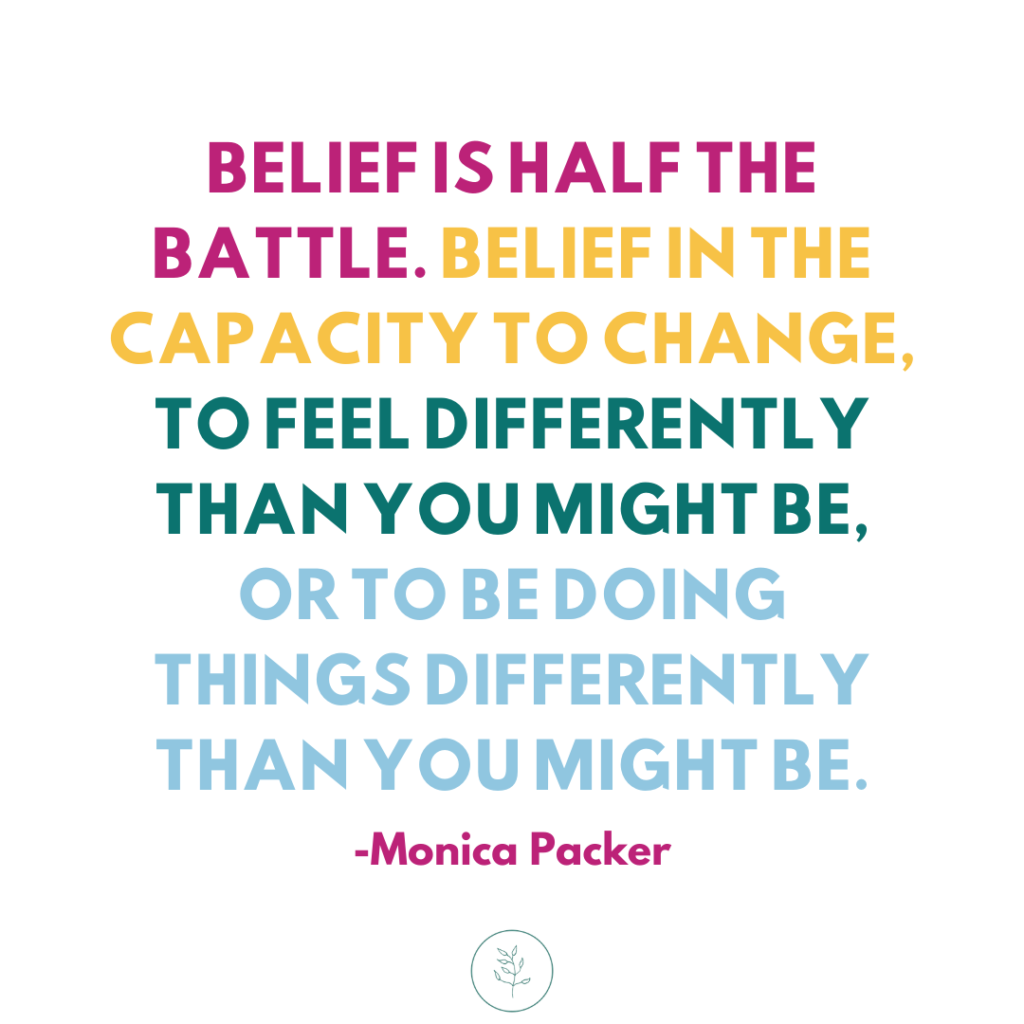
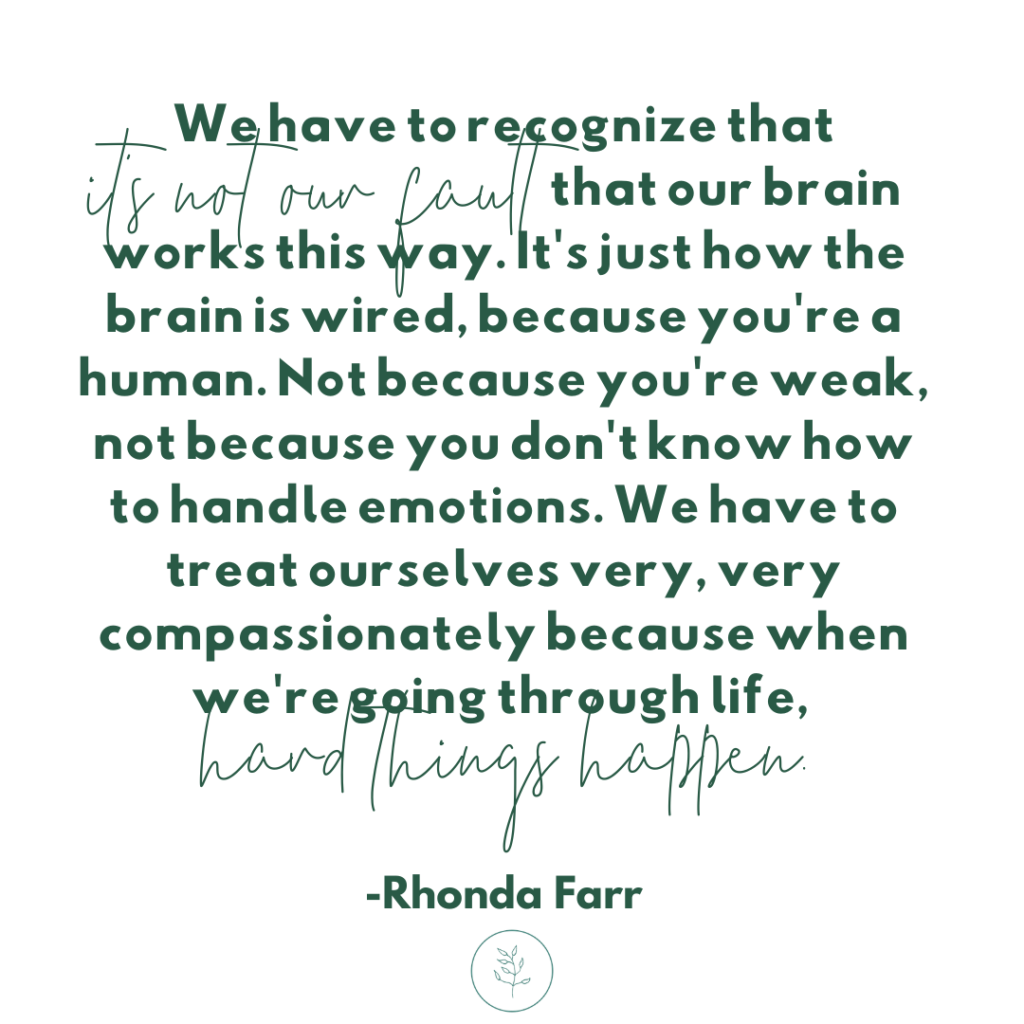
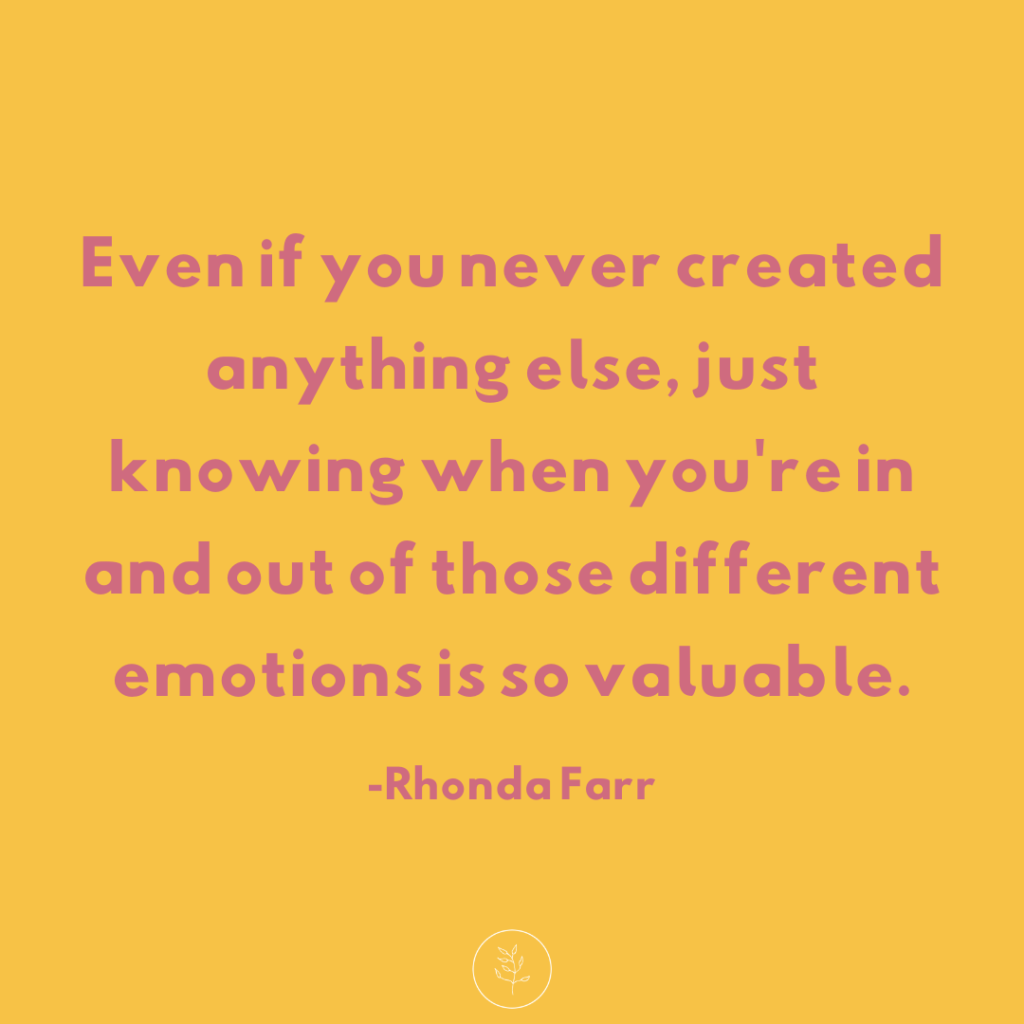
About a few other things…
It’s time to belong to yourself again, so you can belong to your life. Get my free and easy Belonging Guide, where I walk you through how to figure out what’s missing in your life and what you can do about it.
I have a goal to get to 1000 reviews, and I need your help! If you would leave a rating and simple review on Apple Podcast it would really help the show grow, and reach even more women who need this community. I appreciate each one, as well as your shares, it helps me keep the show going and know better how to serve you!
Sign up for the Go Getter Newsletter to get Progress Pointers in your inbox every Thursday.
You can listen the episode below, or on Apple Podcasts/iTunes, Spotify, Youtube, Overcast, Stitcher, Pocketcasts, or search for “About Progress” wherever you get your podcasts. If you like the show please share it, subscribe, and leave a review!!
SHOW NOTES
Rhonda’s Instagram, Website
Leave a rating and review for the podcast!
Miss Kelsey Preschool and Kindergarten Boxes – 20% off with code ABOUTPROGRESS
Try Better Help online therapy 10% off your first month
Free and easy Belonging Guide
Get on the waitlist for the Strive Hive, my monthly membership group
Lend your voice and experience + be featured on the show HERE
Join Monica on Facebook and Instagram
Songs Credit: DRIVE by Dj Nicolai Heidlas @nicolai-heidlas Music provided by FREE MUSIC FOR VLOGS AND VIDEOS bit.ly/freemusicforvlogs
TRANSCRIPT
Monica: [00:00:00] Rhonda Farr, we want to welcome you to About Progress. Thanks so much for being here.
Rhonda: [00:00:05] Thank you. I’m excited to be here.
Monica: [00:00:07] Well, it’s great because we’re going to talk about some complicated things, and this is something that you do every day. This is, this is your scene. And we needed someone like you, who has both the skill set and experience to guide us through emotions.
It’s been an incredibly trying year-plus for all of humanity, which in many ways can be nice because it’s a collective kind of suffering and grief and frustration and stress, and also good things too, like learning about ourselves and uncovering what really matters. But as part of that, we, I think, have been having to face the fact that we can get stuck in some loops about the way that we think and the way that we feel.
And we’re going to talk about all that today, as well as why this is a work you’re passionate about, but can we just start by just setting the scene here of why we as humans get caught in the same emotional loop each day. Why is that the case?
Rhonda: [00:01:08] Okay. So the short answer is because your brain is hardwired for survival and efficiency.
And I’ll explain a little bit more about that, but basically what happens is when we go through life, Our lower brain, our subconscious, literally its only job is to keep you alive. It doesn’t care if you’re happy, it doesn’t care if you’re fulfilling your dreams or if you’re feeling amazing every day, it’s just to keep you alive.
Okay? And the brain wants to be really, really efficient about how it does that. So all of us go through life experiencing things that are pretty emotional. Like you just said, this past year has been pretty emotional and a roller coaster for lots of us. We also go through life, hearing the same messages over and over about ourselves.
Some can be good at a lot of them, not so good. We go through our lives telling ourselves messages about ourselves that are false and less than ideal. Right? So, here’s what the brain does. It takes something that is highly emotionally charged. Let’s talk about that piece first, like the pandemic, or for example, if you suffer loss of a loved one, or maybe, maybe some type of abuse, your brain memorizes that.
Okay. So it’s like a strong, emotional response with a lot of thoughts, and it makes this connection in your mind and it hold onto it. I like to think about it like, like an algorithm. It’s almost like your brain is like, oh, okay. I see. This is how we interpret input. Now things are now dangerous for us. I think about a small child, who’s about to walk out into traffic and the mom is like, don’t go there.
Right? The child. It’s not afraid of the traffic at first, but mom’s screams, it freaks the kid out. He has an emotional response, right? Thoughts about, oh my gosh, what is wrong with my mom? What did I just do? Now? The child is starting to be conditioned to be afraid to walk out into traffic. That’s really good.
Right? It’s
Monica: [00:03:06] we don’t want any kid walking into traffic.
Rhonda: [00:03:10] Oh no. So a lot of times this survival and this efficiency is good, but I want you to think about it from now on when the kid goes to a crosswalk, he doesn’t have to think stop. Look. Is there a car? What about a big truck? Is my mom around? Is anybody here?
We don’t do that. We do it automatically because the brain is so efficient. And when it makes that emotional thought- body connection, our brain just memorizes it. And a lot of ways that is good, but all right, Monica, if somebody says you’re ugly and I can’t stand you, that’s pretty emotional when you’re a teenager, right?
And so we have these thoughts and this feeling and our brain memorizes it and it says peers are dangerous, right. Or my body is dangerous. My body is not safe. And then that becomes our conditioning. We take ourselves out into the world and we see a group of peers and we’re afraid to approach them, or we’re afraid to be ourselves, or we want to hide and cover.
Right. Does that make sense? Like we start to create these connections and then it becomes our conditioning, the way we start to view the world.
Monica: [00:04:24] Yes, it absolutely makes sense. And it’s crazy how it’s so tied to our thoughts and how immediate it is and how even almost to the point where we don’t have to, even, like you said, think. It just is, it goes right to the condition mode.
So before we dig into more of how this can help, let’s talk about one thing that we do see come up in the, in the world right now, a world of self-help, which I am in. You can often see this lend to the toxic positivity side of working on your thoughts, which do matter. And an absolutely can shift everything, but it’s almost like just decide, today’s the day, choose to be happy, like all those kinds of things.
And I’ve had many guests on here who have been through super traumatic, very hard things. And they have said happiness is a choice, ultimately. Right. But it can’t be like a snap your fingers, make achoice and it’s done. So. As part of this conditioning, and I’m sure you’re going to, we’re going to talk about how to work on all of that.
How can we do this in a way that’s still appropriate? Where people have true healing and it doesn’t cause more damage or more trauma or skip over even hard emotions.
Rhonda: [00:05:43] That’s such a good question. And I want to make one more point before I dive into that, you know, it doesn’t actually have to be trauma.
Like we would think of trauma, like maybe abuse or somebody dying. It could just be a message that’s repeated over and over and over. Let’s just say like, you’re the youngest of eight siblings and people are like, be quiet. You’re stupid. And your voice doesn’t matter. Right. And you just. That’s pretty crappy, even though some people wouldn’t say that’s trauma.
Yeah. But you start to think that about yourself. My voice doesn’t matter. It’s not important. And that becomes our conditioning too. Right. So such a great question. When we have these things come up in our lives and I’ll share an experience that I’ve had, that I’ve had to be very compassionate with myself about what we have to recognize is it’s not our fault that our brain works this way.
It’s just how the brain is wired, because you’re a human. Not because you’re weak, not because you don’t know how to handle emotions, which most of us don’t. But, but even if we did even like me, I still get triggered often. I still have to be very aware of this often. We have to treat ourselves very, very compassionately because when we’re going through life, hard things happen.
And when I was 16 years old, I’ll share this quick experience. My brother passed away as a result of a car accident. Now I remember the police officer knocking on the door. Middle of the night. I remember my parents having to call a number. I remember the exact moment they found out. I remember the noises, the smells, the, my dad.
I’ve never seen my dad react that way before. I will never forget that. Right? Tough experience to be a 16 year old and watch your family go through that. And then I had my own feelings. So now I’m a mom. I have four boys. They’ve gotten their driver’s license and they’ve gone out in car. And I saw my friends be a little nervous, but I was like hyper nervous.
And my brother passed away in a car with a friend. So when my kids drive other friends or when they’re with a friend, so emotional for me, and then Monica got to the point, it wasn’t even about cars anymore. Well, when I would drive carpool, I would be driving and I would just be praying, literally praying.
Please bless us to be safe. Help me to get these kids home because. I would never want to inflict that kind of pain on another parent. Right. And that it got to the point where a little kids would come to my house and play. And I would be like, well, let’s not jump on the trampoline. Well, let’s not swing on the swing.
Let’s just play video games. What mom says that? Yeah. But it seemed like the safer option. Right. So for me at first, I didn’t know what was happening. No, I know. Right. Very emotional experience with a lot of emotional thoughts. My brain creates this algorithm. Like, Hey, let’s use that to make sense of the present, no matter what’s going on or where it could possibly fit.
Let’s throw that in there. And then you get a pretty messy mind. So we all have them, but I, yes, in many ways, but yes. So for me, what I. Yeah, it was the, what I started doing is I, when I found out, oh, that’s my conditioning is, this is kind of a trauma response. That’s what I would call it coming up. I just started calling it out everywhere.
I saw it and not in a judging way, but like, oh, that’s not who I am. I’m not this hyper crazy mom or I’m not this super emotional person. That’s a pattern that I learned a long time ago. And I’ve just been repeating it without knowing it. So every time it pops up, I just I’m like, oh, conditioning. I see you again.
And then I’m so compassionate. Of course, that is still popping up. That was so emotional for me. It makes total sense that that’s popping up here. And then I have to be really careful though, not to keep reinforcing it, because what happens is you can also recreate this pattern of, oh, I’m a person who has that conditioning. So I get nervous all the time. Right. And then that becomes my, I am. So we have to be really careful.
Monica: [00:09:44] That makes sense because you don’t, you know, we had different, different reasons why our, our minds can be messy in these regards. Like you said, these conditioned responses and yeah, like you said, there’s a balance between being aware of them and working on calling them out while also not having to step on eggshells the rest of your life, or have other people too.
And I’m sure that takes time and. It’s tricky to learn, but with time will get easier and you’ll be able to, you know, get the balance a little bit better. And thank you so much for telling us about your brother. I mean, my heart goes out to you.
So let’s transition this to women who would like to work on their own conditioning. And you just spoke to, I think the first step, which was one calling out the conditioned responses with compassion. There’s a lot of C words there.
Call out conditional responses with compassion. So let’s move into how then can we. Better create our emotions, because what’s interesting about this conversation is that we’re talking about this during a month where we’re discussing creativity and people are going to be thinking, well, where’s the fine art discussion here?
Like where, where, where is the talking about poetry or writing or dancing again, we’re talking about creating emotion. So that sounds almost too good to be true. So. What is the science behind that? Is it possible? Is it something that we can do? And how has, have you been able to see it work? I mean, obviously within yourself, but also your clients.
Rhonda: [00:11:15] Such a good question. So I won’t go into this too much, but when we recognize these conditions and responses and we have these emotions, there is so much value in processing through that before you try to create. Now, that doesn’t mean you have to be a perfect human before you try to create. Most of us are doing this simultaneously.
Emotions are coming up, we’re recognizing we’re processing and you’ve had other podcasts on that. So we won’t go into that, but it is valuable to know that when you sit down to create, if you’re in this state of like this heightened stress, it might be kind of difficult for you to create these lovy-dovy feel -good emotions, but.
Just, as you said in the beginning about 99% of us are walking through day to day in these thought loops, these memorized patterns that we’re not aware of. The science behind. It says when your brain is wiring and firing thoughts and feelings at the same time, you’re creating neural networks in your brain.
And there is a scientist by the name of HEB. Hubs law is what it’s called. And he says when we fire together wire together, when it comes to the brain, Right, but the opposite is also true. We can learn new patterns of thinking that we want to create. Our emotions are just final product of the experiences that we’re having, whether they’re positive emotions or uncomfortable emotions.
And so when we can start to create these more comfortable emotions, we can wire and fire those together on purpose. So that’s what I teach my clients to do.
Monica: [00:12:53] Oh, it’s fascinating, especially because I think we’ve all heard that, that phrase before wire and fire together, but you’re right. We often think about that more in the negative way.
Yeah. And why, I mean, if that’s true, then it has to be true that it also can be happening in the positive way. And this is where I’m really excited because now you’re going to teach us how to do that, how to work on creating these new neural pathways, neural networks And in a good way. So let’s start, tell us, tell us where we should start in doing this.
Rhonda: [00:13:25] A lot of Times, when my clients want to create something, they will go straight to, oh, Hey, let’s say that I’m going to make a hundred thousand dollars in my business next year, or let’s say, I’m going to paint this beautiful work of art or whatever, and they will sit down and try to think about their goal, which is great, nothing wrong with that.
And then there’ll be like, oh, I should feel amazing. But most clients don’t. And I’m going to tell you why, because their brain goes to the how, but it’s going to take so much time and I’ve never done that before. And so it doesn’t feel great. Like, forget it. I can’t do it. Right. So I would say let’s not even start with the goal at first. Start anywhere you want.
What makes you to feel love and gratitude? I always start with love and gratitude because most of us can figure out a way to tap into those. Is it a sleeping baby? Is it nature. Is it a time that you recall. You’ve had a very spiritual experience that warmed your heart. Like I don’t care what it is. You can bring in anything from your experience that will help you to start to feel on purpose, love, joy, gratitude, any of those.
Like literally anything. One person’s like, I just like to think about snuggling my dog. Cause that’s unconditional love. Yeah, sure. Whatever, but whatever you can do to sort of feel that vibration in your chest, in your heart. So what would you bring into your mind or your imagination?
Monica: [00:14:59] You know, feel good feelings, right? Yeah, for me, that’s always the feeling I get when I’ve climbed a mountain.
Rhonda: [00:15:08] Perfect. So what I would do if I were you, I would like see the mountain and I would have myself looking down on what I had done and looking at the creations around me.
And I would see that visually in my mind. And I just like to drop my shoulders, open up my chest and just breathe into it and start to get to know what that joy, what that gratitude, what that love feels like. Because most of us don’t slow down to actually recognize what it feels like inside.
Monica: [00:15:40] Oh, that’s resonating with me for sure. The slow down. I have to slow down to feel. Who would have thought?
Rhonda: [00:15:47] What does it feel like inside right now for you to think about being on that mountain?
Monica: [00:15:51] Okay. I feel like I’ve got to put myself in that place a little bit. I think I feel a lot of stillness and perspective and clarity. And also just, you know, the general recognition of the beauty and admiring things and just that connection.
Rhonda: [00:16:14] That’s perfect. Okay. Can you think of sensations now? So those were great words and I love it. Clarity, stillness. How does your body feel?
Monica: [00:16:26] If I put myself in that position, I, I think I feel equal parts, grounded and stable, but also light
This is a trickier one for me. And I’m .Sure it’s trickier for a lot of women who, like you have mentioned this disconnect between feelings and the body. That is something I have picked up on in myself and that’s, that’s a little trickier. Yeah.
Rhonda: [00:16:53] Most of us don’t do this. Right. And so then we’re like, Well, we just fall into these patterns of being stressed out and hard on ourselves and all this pressure, because we’re so familiar with those feelings.
Monica: [00:17:07] Describing the, the, the feelings in the body too. Like if you were to ask me how it feels, when I’m overwhelmed, I could tell you what my body feels like, but the good ones, like you said. Yeah. That’s so vital. I have to pick up on that. When it feels good. Okay.
Rhonda: [00:17:24] So, and here’s what that does for you. I literally practice this every single day. Like love and gratitude is where I always teach people to start. Because even though we might not be used to feeling those in our body, we know those, like, those are words that we say, I love you or thank you. So, for most people, it’s a good starting point because they’re familiar with the wording and they have an idea of what it might be like.
Okay. So what happens is when we practice these every day and we start to get really good at pulling those emotions up into our chest or wherever you might feel them, I feel almost every emotion in my chest, but we start to recognize when we fall out of those. So, many of us are stuck in the thought loop of pressure and, you know, self doubt.
And it’s almost like we’re a fish in water. We just live that way, in pressure and self doubt. But when we practice these emotions every day, we have contrast and now we’re like, oh, I can feel the difference. And that in itself, even if you never created anything else, just knowing when you’re in and out of those different emotions is so valuable.
Monica: [00:18:35] It’s also valuable for me to hear that the contrast is good. So when you fall out of them, like you said, it’s not so much that we should shame ourselves or get frustrated with ourselves or either sink in further to the contrasting negative emotions. It’s just a moment to objectively recognize the difference and see it for what it is.
When you say you practice, what does that I’m going right to the how. I’m the how girl, I guess, what does that look like? What do you mean when you practice?
Rhonda: [00:19:09] So when I started this, I literally took out my phone and I put an alarm every day. And whatever time works for you, if your listeners want to practice this, but every day I did it the same time. Now I usually do it. I set my alarm a couple minutes early before I get out of bed and I do it before I even put my feet on the floor. However you want to do it is fine, but I will lie in bed. I like to do it laying down. Usually. And it’s usually more quiet when I’m in my room and the kids are not there.
And I will ask in the beginning, I just thought of anything that felt loving, that felt joyful, that I felt grateful for. And I would set my timer for two minutes, literally just two minutes every day to start. And then I started doing two minutes, a few times a day, but you can do it however you want, but just a specified time to feel on purpose.
Monica: [00:20:02] Hmm. Oh, you were just hitting me right and left, Rhonda. This is, I feel like this has almost been a personal session just for me. So thank you. But when I think about the women who are like me and listening, I can see how we could get tripped up. Even in the beginning. Like I thought I had needed to be really specific about what my goals were and then what my emotions I wanted to feel.
And then to recall those and no you’re saying no, let’s just start more generally. Let’s just get into the pattern of recollection of good emotions and a connection to them so that we can better recognize them. And then, and then do you go on to creation? I’m assuming.
Rhonda: [00:20:44] Yeah, we’ll talk about that in a minute, but I want to give you one more, super fun by-product of this. You start to notice the contrast, which is perfect. It’s beautiful. Because then when you’re having a grumpy day, you’ll be like, oh, this feels different. I used to not even notice when I was frustrated all day now, I actually realized there’s a contrast. And then the second beautiful by-product is you start to be more confident in your ability to feel on purpose.
You start to feel more confident that you can find love and gratitude. When it’s hard, you start to be able to create that so much more quickly than you ever could have before without the practice.
Monica: [00:21:25] So you gain confidence in your abilities to feel good. Yeah. Is that what you mean?
Rhonda: [00:21:31] Basically, you gain confidence that when somebody, because let’s be honest, I said this in the beginning, I still struggle.
Like I still have kids who don’t do their homework and I still have a bad day, but I also know when I can ground myself and I can process those emotions. I’m going to be able to get myself back to this energy that I want to be creating from, to this energy that I want to be interacting with others from.
Monica: [00:21:58] Don’t you feel like, and I’m sure in your work, you see this a lot. That belief is half the battle belief in the capacity to change, to feel differently than you might be, or to be doing things differently than you might be. I think that honestly has been in my own life and in my own work experience with, with many women is belief has half the battle.
And I love that this is, you’re showing us how to create both the belief and the logistical practice of making this a possibility that is so powerful. I really appreciate that breakdown. So once we have gained confidence and belief in ourselves, then what’s next. Yeah.
Rhonda: [00:22:40] Hmm. Okay. So here’s what I like to do.
Here comes the creation part, right? So when we start to feel that love and gratitude, and we’re getting pretty good at it, like we can draw it in and as you practice this, I think you and your listeners will be surprised at how good you become at it over time. So let’s say you’ve been doing it for a month and you’re like, man, I can lie down and I can pull that love and gratitude up pretty quickly.
And it’s strong. Then I start to bring pictures into my mind of my goal. Whatever it might be. So I have a coaching business and sometimes I think about something I want to create for my clients, or maybe even how many clients I want to have. Sometimes I just think about this new home that I want to build for my family that has more room.
We are busting at the seams in this house that we’re in. And sometimes I’ll think about that. Like, whatever it is that you want to create. I still want you to pull it up the love and gratitude any way that feels most comfortable, comfortable to you. And then start to pull in pictures in your mind of this goal, pictures of this future destination that is possible for you.
And some of your listeners are going to be like, how do I know it’s possible? If you have a desire for it, it is possible. Just trust me on that.
Monica: [00:24:02] So that’s where we start. Just like you were saying that smart. Just earlier, when we were trying to recall the good emotions, we first pictured it and then we feel it.
So the same thing here later, once you get stronger and you’re ready to work towards a literal goal with literal emotions attached to it, you start by visualizing the outcome and then bringing that emotion.
Rhonda: [00:24:25] Yeah. Some people can do that. So let’s talk about, I’m so glad you asked that. Okay. Some people can think about their goal and bring up that joy and gratitude.
And if you can do that, do it, but a lot of people I’m going to go ahead and warn you. A lot of people get hung up on, they bring up this big goal. Let’s say they have this business idea and they can see it in their mind and they’re super excited about it. But when they start to see it, they don’t feel very joyful or they don’t feel very grateful because their brain automatically goes to the how. And if that happens to you, I want you to bring up the love and gratitude with any, any means that you have to, however you were doing it during your practice, bring up the love and gratitude.
And then we just put a picture of the goal in our mind and our brain is going to say, but you don’t know how yet, but you don’t deserve that. And we’re going to say, I hear you brain. I’m just thinking about it. I hear you brain. I’m just looking at the picture of it right now. So we’re just gonna try to do a little bypass of that and let him know. We hear it. We’re acknowledging and then letting it go. And just looking at the picture while we feel the emotion
Monica: [00:25:35] and is that where we wire and fire and so what’s happening. Okay.
Rhonda: [00:25:40] Yes. That’s where we’re wiring and firing the positive, what we want. Do you remember Johns Hopkins did this. Study, if you’ve ever taken a psychology class, you’ve probably heard about little Albert. It was in the 19 hundreds and it was this baby who they wanted to condition. He was emotionally sound child. They did all this testing and they’re like, oh yeah, he’s an emotionally sound child. And then they started showing him a little furry things, right? Like a cute little mouse or a little bunny rabbit.
And every time he started to touch it, they would like bang behind him as loud as they could. And it scared the crap out of this little kid. And before long, he was afraid of anything white or fluffy. They had conditioned him by that loud noise. To be afraid of everything. Do you remember that?
Monica: [00:26:25] Yes. I remember psychology 1 0 1, like briefly going over that.
Yeah.
Rhonda: [00:26:32] So I know poor Albert, wasn’t that awful? We’re doing the opposite of that. So now, you know, instead of creating the terrible, fearful, loud noise that scares us to death and giving us a picture of it. We’re creating joy and love and gratitude. And we’re bringing in the picture of what we want. We’re wiring and firing the emotion with our goal.
Monica: [00:27:00] I’m loving this bypassing the how Because I’m totally one of those people,
Rhonda: [00:27:07] Most of us are.
Monica: [00:27:08] That’s nice to hear that. Yeah. And so what this does, what does that do then for our, for our goals, like the wiring firing is good and that will make it feel better, but then how does that help us move forward in ways that can also enable us to move closer to the things we want to change and the things we want to improve in our lives.
Rhonda: [00:27:30] Well, I’m so glad you asked. So what it does for us is it helps us to start creating that belief that you just brought up. Right? So we no longer like, oh, goals are so scary. Mean, we might have a little bit of that, right. But when we start to associate our goal with these positive feelings, these positive emotions, then we naturally and organically start to step closer to the goal.
We start to take actions organically that lead us where we want to be. I had a coach one time, she was talking about emotions and she was talking about uncomfortable emotions, unwanted emotions, like self-doubt and anxiety. And she was like, sometimes we just have to put those in the passenger seat of the car and keep going anyway.
And I thought about that, you know? When we’re walking toward our goal, we’re still gonna have some thoughts of self-doubt because we’re human. Even if we have this positive association, this positive conditioning with it, those thoughts will jump in sometimes. But I think it’s so important that as we’re creating these positive emotions, we have that contrast again.
Right. And we feel the self-doubt come on and we’re like, oh, that’s new. Hey, you’re going to be in the passenger seat. And sometimes if we go numb or if we go If we like go cold to our emotions again and stop acknowledging them that emotion will get on our lap, grab the driver’s wheel and take us to a place that we don’t want to go.
And we’re like, how do we get there? But if we’re acknowledging those emotions and saying, I hear you, you can sit in the driver’s seat, but I’m going to move toward my goal. We keep our hands on the wheel and we keep taking steps towards what we choose. Not where our emotions unintentionally lead us without our permission.
Monica: [00:29:20] Oh. So that’s so clear to me. Thanks for that analogy because it’s not like you’re like, pretending they’re not there. It’s an acknowledgement, but it’s not indulging them. That’s a big contrast. And again, this is still talking about, you know, the non no trauma are really, really hard things, but let’s, let’s bring that up one more time though. Does this still work with things like that that are a little bit harder to process long-term.
Rhonda: [00:29:51] Yeah. So when you reach for a big goal, you should definitely expect past traumas or false beliefs from your past to come up. That’s just what happens to almost every single one of us. Because again, that lower brain is only there for survival. So it will tell you all the reasons it’s not safe to go big and it will remind you over and over again to stop it right now.
Monica: [00:30:14] Yep. Stay here. This is what we know. We want to stay right here. This is comfortable. Yeah.
Rhonda: [00:30:22] Yeah, exactly. It’s familiar, but it’s not always fun. Yeah. I expect those to come up and here’s what I like to do. I just like to say, I hear you, you’re trying to tell me some thing and I do have very specific ways. If there’s a strong emotion that comes up, that I go in and help my clients process those.
But let’s just say that you’re having a day where you’re trying to complete a big part of your goal. A strong emotion comes up that you’re not super excited about like anxiety or self doubt. I might just say, I hear you, you’re going to be in the passenger seat today while I create, and I also can hold that emotion with the love.
Like we can hold two emotions at the same time. Hmm. I don’t know if people know all that,
Monica: [00:31:03] but we, you don’t even recognize it. Yes. Yeah, totally. And frustration for the people that that’s the example I can think of. You can feel both love and frustration with someone that is really important to you. So yeah.
Why can’t we do that with ourselves?
Rhonda: [00:31:20] A hundred percent. So I might go on and create that love and gratitude for my goal and feel that self-doubt. But I am going to come back to that self doubt and I am going to process through it. And if I need help to actually go beneath the surface and heal, I’m going to hire a therapist, a counselor, or a coach who is trained to do so.
And I’m going to have help while I’m doing it for sure.
Monica: [00:31:42] Oh, great distinctions there. Such good distinctions. This has been monumentally helpful for me. I know for my community too. You’re going to have to come back on here, Rhonda. We’ll have to do part two through 10. I mean, I’m sure eventually it’s going to be that many.
We might as well call us the Ronda Show. I think moving forward.
Rhonda: [00:32:02] Oh, you’re so nice.
Monica: [00:32:04] It was so good. Thank you again. So let’s, let’s apply this to not apply. I want to transition to talking about you. And what you are working on right now, we talked about goals and all that. That’s great. But what about in your own personal life?
What is something that you are working on right now so that we can see the human in you and that this is a process as well that you have to move through.
Rhonda: [00:32:27] Okay. So maybe 10 years ago I was resentful at my husband. I had thought I married the wrong person. I was living in my family paycheck to paycheck.
You know, I don’t want to pretend I have this terrible story, but I kind of grew up just thinking that having enough is enough. I grew up around a lot of people who didn’t even have their basic needs met. So it felt very unrighteous to ask for more and it felt very snotty of me to want more. And so now I want to give Rhonda 10 years ago, all the people like me resource so they can realize what their conditioning is.
They can understand and learn how to create. So I’m actually, I’m in the process of creating a free course that will change people’s lives. Like I want to help me cause I, I wouldn’t have hired a coach 10 years ago. I didn’t think I had enough money. Right. And I’ve thought about that a bunch of times I help a lot of people, but I don’t help the people like me who think, “I can’t afford you. And I’m so frustrated and angry and it probably wouldn’t work anyway.” So I’m in the process of doing that and, and you know what that means. I’m having peel my relationship with money to be able to teach other people how to do that. And I’m having to heal my identity around money and my identity.
In my relationships. I mean, I related to people for years like parents and other family members here. Let me just give you the money. That’s how I show love. And that’s how I would receive love. And that’s kind of our order in the family, on my husband’s side and my side, that’s just who we were. We were the people who needed a little help and it made them feel good to help us.
And it made us feel good that somebody was willing to. I’m like, wait a minute. I don’t want to be that person. There’s so much Morphy. I want to walk into a relationship and be me, not somebody who needs your money and gets love that way. You know, I am still healing that, and I will say, I hope it’s appropriate to bring this up too.
Even my relationship with God was tied up in scarcity. Like all my prayers were, please give me this. And I’m begging for that. And oh, deliver us. And. Since I’ve started to create these feelings of more abundance and love and gratitude. I don’t feel that way anymore. And I had this moment, I was like, wait, I don’t feel as close to God anymore.
Oh, what is happening? And I got scared. And then I realized, oh, it’s because I’m not begging in scarcity all the time. And now I get to decide. Who I want to be in that relationship. And I get to know him on a, such a different level. It’s like, I’m working on all of it. I am a human.
Monica: [00:35:12] You hear a whole hour of that. Again, so many connections, you know, between you and I, but also so many people listening. This, this is resonating on all levels. Rhonda, I am so appreciative that you would take the time. I mean, I feel like what you did is you just poured your many years of work into a short episode together. And the generosity in sharing that with us is really touching to me.
So I just want to thank you for being here and for so generously giving of all of that to us.
Rhonda: [00:35:47] Oh, you’re welcome.
